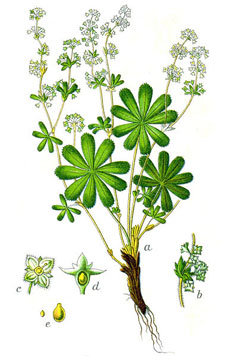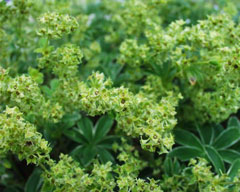 |
|
http://commons.wikimedia.org/wiki/File:Alchemilla_alpina_Sturm56.jpg |
 |
| http://commons.wikimedia.org/wiki/User:Abalg |
Translate this page:
Summary
Bloom Color: Green, Yellow.
Main Bloom Time: Mid summer. Form: Rounded, Spreading or horizontal. Form: Rounded, Spreading or horizontal.
Physical Characteristics

 Alchemilla alpina is a PERENNIAL growing to 0.2 m (0ft 8in) by 0.2 m (0ft 8in) at a medium rate.
Alchemilla alpina is a PERENNIAL growing to 0.2 m (0ft 8in) by 0.2 m (0ft 8in) at a medium rate.
See above for USDA hardiness. It is hardy to UK zone 5 and is not frost tender. It is in flower from June to September, and the seeds ripen from August to October. The species is hermaphrodite (has both male and female organs) and is pollinated by Apomictic (reproduce by seeds formed without sexual fusion). The plant is self-fertile.
Suitable for: light (sandy), medium (loamy) and heavy (clay) soils, prefers well-drained soil and can grow in heavy clay soil. Suitable pH: mildly acid and neutral soils. It can grow in semi-shade (light woodland) or no shade. It prefers dry or moist soil.
UK Hardiness Map
US Hardiness Map
Synonyms
Plant Habitats
Woodland Garden Sunny Edge; Cultivated Beds;
Edible Uses
Edible Parts: Leaves
Edible Uses: Tea
The following uses are for A. vulgaris. They quite probably also apply for this species[K]. Young leaves - raw or cooked[5, 7]. A dry, somewhat astringent flavour[K]. They can be mixed with the leaves of Polygonum bistorta and Polygonum persicaria then used in making a bitter herb pudding called 'Easter ledger' which is eaten during Lent[177, 183]. Root - cooked. An astringent taste[4]. The leaves are used commercially in the blending of tea[7].
References More on Edible Uses
Medicinal Uses
Plants For A Future can not take any responsibility for any adverse effects from the use of plants. Always seek advice from a professional before using a plant medicinally.
Alterative Antirheumatic Astringent Diuretic Emmenagogue Febrifuge Sedative Styptic
Tonic Vulnerary
Lady's mantle has a long history of herbal use, mainly as an external treatment for cuts and wounds, and internally in the treatment of diarrhoea and a number of women's ailments, especially menstrual problems[9, 244]. This plant, the alpine ladies mantle, has been shown to be more effective in its actions[238, 268]. The herb is alterative, antirheumatic, astringent, diuretic, emmenagogue, febrifuge, sedative, styptic, tonic and vulnerary[4, 7, 9, 21, 46, 165]. The leaves and flowering stems are best harvested as the plant comes into flower and can then be dried for later use[4]. The fresh root has similar and perhaps stronger properties to the leaves, but is less often used[4]. The plant is rich in tannin and so is an effective astringent and styptic, commonly used both internally and externally in the treatment of wounds[4]. It helps stop vaginal discharge and is also used as a treatment for excessive menstruation and to heal lesions after pregnancy[4, 244]. Prolonged use can ease the discomfort of the menopause and excessive menstruation[268]. The freshly pressed juice is used to help heal skin troubles such as acne and a weak decoction of the plant has been used in the treatment of conjunctivitis[244].
References More on Medicinal Uses
The Bookshop: Edible Plant Books
Our Latest books on Perennial Plants For Food Forests and Permaculture Gardens in paperback or digital formats.

Edible Tropical Plants
Food Forest Plants for Hotter Conditions: 250+ Plants For Tropical Food Forests & Permaculture Gardens.
More

Edible Temperate Plants
Plants for Your Food Forest: 500 Plants for Temperate Food Forests & Permaculture Gardens.
More

More Books
PFAF have eight books available in paperback and digital formats. Browse the shop for more information.
Shop Now
Other Uses
References More on Other Uses
Cultivation details
Landscape Uses:Alpine garden, Border, Container, Ground cover, Rock garden. Easily grown in ordinary soil in sun or part shade[1, 233]. Prefers a well-drained acid soil[200, 238]. Grows well in heavy clay soils. Succeeds in dry shade[188]. Plants in this genus seem to be immune to the predations of rabbits[233]. Special Features:Attractive foliage, Not North American native, Suitable for cut flowers, Inconspicuous flowers or blooms.
References Carbon Farming Information and Carbon Sequestration Information
Temperature Converter
Type a value in the Celsius field to convert the value to Fahrenheit:
Fahrenheit:
The PFAF Bookshop
Plants For A Future have a number of books available in paperback and digital form. Book titles include Edible Plants, Edible Perennials, Edible Trees,Edible Shrubs, Woodland Gardening, and Temperate Food Forest Plants. Our new book is Food Forest Plants For Hotter Conditions (Tropical and Sub-Tropical).
Shop Now
Plant Propagation
Seed - sow spring in a cold frame. The seed usually germinates in 3 - 4 weeks at 16°c[133]. When large enough to handle, prick the seedlings out into individual pots and grow them on a cold frame for their first winter, planting out in late spring or early summer. Division in spring or autumn. The divisions can be planted out direct into their permanent positions, though we find it best to pot them up and keep them in a sheltered position until they are growing away well.
Other Names
If available other names are mentioned here
Native Range
EUROPE: Finland, United Kingdom, Ireland, Iceland, Norway, Sweden, Italy, Spain, France
Weed Potential
Right plant wrong place. We are currently updating this section.
Please note that a plant may be invasive in one area but may not in your area so it's worth checking.
Conservation Status
IUCN Red List of Threatened Plants Status :

Growth: S = slow M = medium F = fast. Soil: L = light (sandy) M = medium H = heavy (clay). pH: A = acid N = neutral B = basic (alkaline). Shade: F = full shade S = semi-shade N = no shade. Moisture: D = dry M = Moist We = wet Wa = water.
Now available:
Food Forest Plants for Mediterranean Conditions
350+ Perennial Plants For Mediterranean and Drier Food Forests and Permaculture Gardens.
[Paperback and eBook]
This is the third in Plants For A Future's series of plant guides for food forests tailored to
specific climate zones. Following volumes on temperate and tropical ecosystems, this book focuses
on species suited to Mediterranean conditions—regions with hot, dry summers and cool, wet winters,
often facing the added challenge of climate change.
Read More
Expert comment
Author
L.
Botanical References
200
Links / References
For a list of references used on this page please go here
Readers comment
© 2010, Plants For A Future. Plants For A Future is a charitable company limited by guarantee, registered in England and Wales. Charity No. 1057719, Company No. 3204567.